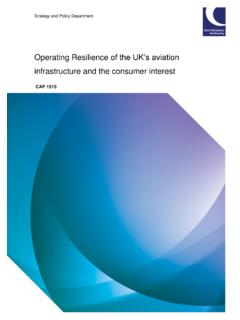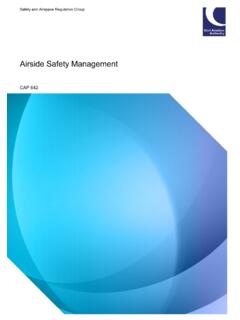Transcription of Corrosion and Inspection of General Aviation Aircraft - CAA
1 Corrosion and Inspection of General Aviation Aircraft CAP 1570 Published by the Civil Aviation Authority, 2017 Civil Aviation Authority Aviation House Gatwick Airport South West Sussex RH6 0YR You can copy and use this text but please ensure you always use the most up to date version and use it in context so as not to be misleading, and credit the CAA. First published July 2017 Enquiries regarding the content of this publication should be addressed to: The latest version of this document is available in electronic format at CAP 1570 Contents July 2017 Page 3 Contents Chapter 1 6 Introduction 6 Chapter 2 8 Theory of Corrosion 8 Types of Corrosion 9 Direct Chemical Attack 10 Electrochemical Attack 10 Chapter 3 13 Types of Corrosion 13 Anodic (Galvanic) Corrosion 14 Intergranular Corrosion 15 Filiform surface Corrosion 16 Pitting or General Surface Corrosion 17 Stress Corrosion Cracking 18 Fretting 19 Exfoliation 19 Crevice (Concentration Cell)
2 Corrosion 20 Micro-Biological 21 Chapter 4 23 Causes of Corrosion 23 Climate 23 Foreign Material 23 Chapter 5 24 Environment 24 Chapter 6 25 Spillage 25 Chapter 7 26 Exhaust gasses 26 CAP 1570 Contents July 2017 Page 4 Chapter 8 27 Corrosion prevention 27 Chapter 9 34 In-service aspects 34 Aircraft Cleaning 34 Exterior Cleaning 35 Interior Cleaning 36 Types of Cleaning Operations 37 Non-flammable Aircraft Cabin Cleaning Agents and Solvents 38 Flammable and Combustible Agents 39 Container Controls 39 Fire Prevention Precautions 39 Fire Protection Recommendations 40 Powerplant Cleaning 41 Solvent Cleaners 42 Emulsion Cleaners 43 Soaps and Detergent Cleaners 44 Mechanical Cleaning Materials 44 Chemical Cleaners 45 Chapter 10 46 Inspection for Corrosion 46 Chapter 11 48 Examination 48 Visual 48 Light Probes 48 Non-Destructive 51 Chapter 12 54 Treatment of Corrosion 54 Chemical Treatments 54 Anodizing 54 Alodizing 55 Chemical Surface Treatment and Inhibitors 55 CAP 1570 Contents July 2017 Page 5 Chromic Acid Inhibitor 56 Sodium Dichromate Solution 56 Chemical Surface Treatments 56 Chapter 13 57 Categories and limits of Corrosion 57 Chapter 14 58 Bibliography 58 Chapter 15 59 Design references 59 CAP 1570 Chapter 1: Introduction July 2017 Page 6 Chapter 1 Introduction All designers, maintainers, inspectors and owners have a part to play in preventing Aircraft being adversely affected by metallic Corrosion .
3 They must think about different types of Corrosion and those factors that need to be considered during design, design approval and subsequent maintenance. Pilots, Aircraft owners and inspectors should also be aware of the possible effects that Corrosion might have on an Aircraft , what to look for during their routine checks and the potential safety impact if Corrosion is overlooked. Aircraft designers and inspectors should also be aware of the relevant Corrosion protection, Inspection and related Inspection access design requirements of BCAR Section S, EASA CS-VLA and Acceptable Means of Compliance, (that achieve an equivalent level of safety), when undertaking design approval and acceptance inspections respectively references are included in the following text. General guidance is provided in this publication on the design, assembly and Inspection of various parts of an Aircraft structure. Those areas that because of their remoteness, complexity or boxed-in nature and are not readily accessible during routine maintenance or require attention in the light of operational experience are highlighted.
4 Corrosion can result in a significant decrease in the thickness of original load bearing material that can lead to a loss of structural integrity and potentially to catastrophic failure. In the case of more highly stressed parts, finding and rectifying Corrosion damage can help to prevent the early initiation of fatigue cracking from Corrosion pits that can also lead to premature structural and catastrophic failures. This has been observed in aluminium alloy forgings and light Aircraft landing gear components, where a mixture of exfoliation and pitting Corrosion on the flash line initiated stress Corrosion cracking that then lead to Corrosion fatigue, normal fatigue and exfoliation. Routine in-service inspections that lead to the early detection of Corrosion and consequent rectification can also prevent more costly, extensive and invasive repair actions later. This can be achieved on Primary structures that are not concealed and can be easily inspected for condition in-service.
5 Deterioration of Aircraft structure may arise from various causes and can affect all parts of the structure according to the design of the Aircraft and the uses to which it is put. This publication should be read in conjunction with the appropriate manufacturer s publications, where provided OEM Standard Practices and CAP 1570 Chapter 1: Introduction July 2017 Page 7 the Maintenance Programme for the Aircraft concerned. In addition further information on Corrosion can be found as referenced in chapter 14. Although guidance may be given in publications as to suitable opportunities for inspecting normally inaccessible structures ( when a wing tip is removed permitting access to the adjacent wing structure) experience should indicate to the operator further opportunities for such inspections which can be included in the Maintenance Programme. Apart from the airworthiness aspects, these combined inspections could often be to the operator s advantage, since they could reduce or remove the need for future dismantling that might otherwise be dedicated to periodic Corrosion driven inspections.
6 Thus when access has been gained to a part of the airframe which is normally inaccessible, advantage should be taken of this dismantling to inspect all parts of systems and structures thus exposed. When evidence of Corrosion is found it is critical that the full extent and nature of the Corrosion be established and repaired, even if these means additional access, dismantling or a special Inspection technique to facilitate such deeper Inspection and subsequent rectification actions. The presence of Corrosion in Aircraft will lead to deterioration in the Aircraft s structure which may eventually lead to catastrophic failure. It is therefore essential that any signs of Corrosion are detected in the earliest stages of its development, assessed and addressed as appropriate. Development of Corrosion over time is influenced by a variety of factors as will be described subsequently. Prevention is always better than cure, and by ensuring suitable Corrosion protection on individual detail parts prior to and during assembly the onset of Corrosion can be prevented or significantly delayed.
7 Note: Whilst this publication contains guidance principally aimed at General Aviation Aircraft , the content can also be seen as more widely relevant to non-GA types which are similarly vulnerable to Corrosion . Accordingly a number of the Corrosion examples described and associated photographs that follow involve non-GA types. CAP 1570 Chapter 2: Theory of Corrosion July 2017 Page 8 Chapter 2 Theory of Corrosion The following text has been extracted from the US Department of Transportation, Federal Aviation Administration (FAA), Flight Standards Service FAA-8083-30 Aviation Maintenance Technical Handbook, Chapter 6 Aircraft Cleaning and Corrosion Control (2008) - the FAA text has not been revised save for spelling changes to UK English and in order to provide correct cross-references in the text to embedded photographs and diagrams. Metal Corrosion is the deterioration of the metal by chemical or electrochemical attack.
8 This type of damage can take place internally as well as on the surface. As in the rotting of wood, this deterioration may change the smooth surface, weaken the interior, or damage or loosen adjacent parts. Water or water vapour containing salt combines with oxygen in the atmosphere to produce the main source of Corrosion in Aircraft . Aircraft operating in a marine environment, or in areas where the atmosphere contains industrial fumes that are corrosive, are particularly susceptible to corrosive attacks. Photograph 1. Direct chemical attack in a battery compartment CAP 1570 Chapter 2: Theory of Corrosion July 2017 Page 9 If left unchecked, Corrosion can cause eventual structural failure. The appearance of Corrosion varies with the metal. On the surface of aluminium alloys and magnesium, it appears as pitting and etching, and is often combined with a grey or white powdery deposit. On copper and copper alloys, the Corrosion forms a greenish film; on steel, a reddish Corrosion by-product commonly referred to as rust.
9 When the grey, white, green, or reddish deposits are removed, each of the surfaces may appear etched and pitted, depending upon the length of exposure and severity of attack. If these surface pits are not too deep, they may not significantly alter the strength of the metal; however, the pits may become sites for crack development, particularly if the part is highly stressed. Some types of Corrosion burrow between the inside of surface coatings and the metal surface, and can spread until the part fails. Types of Corrosion There are two General classifications of Corrosion that cover most of the specific forms: direct chemical attack and electrochemical attack. In both types of Corrosion , the metal is converted into a metallic compound such as an oxide, hydroxide, or sulphate. The Corrosion process always involves two simultaneous changes: The metal that is attacked or oxidized suffers what may be called anodic change, and the corrosive agent is reduced and may be considered as undergoing cathodic change.
10 Diagram 1. Electrochemical attack CAP 1570 Chapter 2: Theory of Corrosion July 2017 Page 10 Direct Chemical Attack Direct chemical attack, or pure chemical Corrosion , is an attack resulting from a direct expo-sure of a bare surface to caustic liquid or gaseous agents. Unlike electrochemical attack where the anodic and cathodic changes may be taking place a measurable distance apart, the changes in direct chemical attack are occurring simultaneously at the same point. The most common agents causing direct chemical attack on Aircraft are: Spilled battery acid or fumes from batteries; Residual flux deposits resulting from inadequately cleaned, welded, brazed, or soldered joints; and Entrapped caustic cleaning solutions. [Photograph 1] With the introduction of sealed lead-acid batteries and the use of nickel-cadmium batteries, spilled battery acid is becoming less of a problem. The use of these closed units lessens the hazards of acid spillage and battery fumes.









